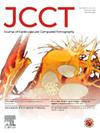Membranous septum area and the risk of conduction abnormalities following transcatheter aortic valve implantation
IF 5.5
2区 医学
Q1 CARDIAC & CARDIOVASCULAR SYSTEMS
引用次数: 0
Abstract
Background
Conduction abnormalities (CA) after TAVI remain problematic. Membranous septum (MS) depth correlates inversely with new CA though within-patient variability exists.
Objectives
To determine the association of CT-derived MS area with new CA after TAVI.
Methods
MS depth was measured along its width (20 % intervals) to calculate MS area in 140 patients without CA. The primary outcome was PPI or new persistent LBBB at discharge.
Results
New CA occurred in 49 (35 %) patients of whom 10 (7.1 %) required PPI and 39 (27.9 %) developed persisting LBBB. MS area was significantly smaller in those with new CA (20.1 [8.6] vs. 41.2 [18.0] mm2; p < 0.01). By multivariable regression, a model including MS area and TAVI contact (MS width∗implant depth): MS area ratio showed better discrimination for new CA compared with a model including MS depth and MS depth – implant depth (AUC 0.89 [95 % CI 0.83–0.94] vs. 0.84 [95 % CI 0.76–0.90]; p = 0.05, respectively). Optimal cut off point for correct classification of new CA for MS depth was 3.9 mm (sensitivity 73 %, specificity 76 %, PPV 58 % and NPV 84 %), 28.0 mm2 for MS area (sensitivity 88 %, specificity 78 %, PPV 68 % and NPV 92 %) and 1.88 (sensitivity 63 %, specificity 81, PPV 77 % and NPV 68 %) for TAVI contact: MS area ratio. To minimize new CA, maximal valve implant depth should ≤ (1.88 ∗ MS area)/MS width.
Conclusions
Pre-procedural assessment of the MS area offers additional predictive value for development of new conduction abnormalities after TAVI when compared with MS depth and can guide implant depth.
经导管主动脉瓣植入术后膜间隔面积与传导异常的风险。
背景:TAVI后的传导异常(CA)仍然存在问题。膜隔(MS)深度与新CA呈负相关,但患者内部存在差异。目的:探讨TAVI术后ct衍生MS区域与新发CA的关系。方法:在140例无CA的患者中,沿其宽度(20%间隔)测量MS深度以计算MS面积。主要结局是出院时PPI或新的持续性LBBB。结果:49例(35%)患者发生新的CA,其中10例(7.1%)需要PPI, 39例(27.9%)发展为持续性LBBB。新发CA患者的MS面积明显较小(20.1 [8.6]vs. 41.2 [18.0] mm2;TAVI接触:质谱面积比p < 2(灵敏度88%,特异度78%,PPV 68%, NPV 92%), p < 1.88(灵敏度63%,特异度81,PPV 77%, NPV 68%)。为了减少新的CA,最大瓣膜植入深度应≤(1.88 * MS面积)/MS宽度。结论:与MS深度相比,术前MS区域评估对TAVI后新的传导异常的发展提供了额外的预测价值,可以指导植入物深度。
本文章由计算机程序翻译,如有差异,请以英文原文为准。
求助全文
约1分钟内获得全文
求助全文
来源期刊

Journal of Cardiovascular Computed Tomography
CARDIAC & CARDIOVASCULAR SYSTEMS-RADIOLOGY, NUCLEAR MEDICINE & MEDICAL IMAGING
CiteScore
7.50
自引率
14.80%
发文量
212
审稿时长
40 days
期刊介绍:
The Journal of Cardiovascular Computed Tomography is a unique peer-review journal that integrates the entire international cardiovascular CT community including cardiologist and radiologists, from basic to clinical academic researchers, to private practitioners, engineers, allied professionals, industry, and trainees, all of whom are vital and interdependent members of our cardiovascular imaging community across the world. The goal of the journal is to advance the field of cardiovascular CT as the leading cardiovascular CT journal, attracting seminal work in the field with rapid and timely dissemination in electronic and print media.
 求助内容:
求助内容: 应助结果提醒方式:
应助结果提醒方式:


